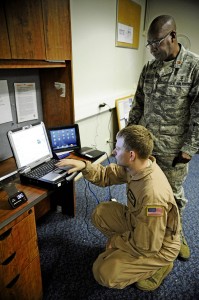A new “my Wi-Fi” hot spot device was tested by aeromedical evacuation crewmembers July 19. “My Wi-Fi” is a secure, off-the-shelf device that acts as a hot spot and allows aeromedical evacuation crewmembers to send patient records to that person’s next location before they arrive.
“It will be noticed more up at (Landstuhl Regional Medical Center) where they accept trauma victims,” said Tech. Sgt. Jonathan Andrew, 375th Aeromedical Evacuation Squadron flight instructor. “They would be able to see the patient’s record before that person gets to LRMC and prepare for what they need to do.”
This new device helps decrease human errors, enhances warfighter safety and security, and ventures away from paper records.

While in flight, the wireless router is used to connect up to 10 devices in order to communicate effectively, and once the aircraft touches ground, the “my Wi-Fi” device is used to send the patient’s records to the facility providing care to that patient.
“On aeromedical evacuation missions, the paper documents rarely make it into the patient’s record,” Andrew said. “This electronic health record system helps get those important files into the patient’s records.”
Crews on the aeromedical evacuation flights currently have laptops assigned to them; however, those laptops were unable to communicate with one another. The wireless router will allow the laptops to be linked, and crewmembers will be able to share patient information without having to switch laptops.
“Before having ‘my Wi-Fi,’ transferring patient records was very labor intensive,” said Brooke Stauner, Theater Medical Information Program contractor. “This is huge.”
Having an ever-changing process, the users constantly have training to keep up-to-date on the new things that become available.
“Like everything else that is technology based, we have to be open-minded with this whole process,” said Maj. Justice Sakyi, Air Mobility Command division chief. “We are always getting feedback from those in the field using the equipment and trying to improve it and make it better.”
Keeping the patient’s records together is an important goal, especially when it comes to receiving veteran’s benefits. If their records aren’t complete, they won’t be able to receive the proper treatment and benefits, Stauner said.
“Our long term goal is to keep the warfighters safe and give them the help they need in a timely manner as well as make the providers’ lives easier,” Sakyi said. “Once the testing is complete, all 32 aeromedical evacuation squadrons, as well as all deployed locations, will have access and training to use this program.”


